The American plan for the invasion of Upper Canada would be a simple one. A coordinated three-pronged attack that would strike at Fort Amherstburg in the West, Montreal in the East, and the Niagara Penisula in the center. But in the 19th-Century coordinating three attacks with such vast distances between them was impossible. The Americans also believed that the local population would welcome them as liberators, not invaders. The quick turnabout at Detroit proved this second part wrong. And while General Isaac Brock proved himself the Saviour of Upper Canada at Detroit he would soon face both his next challenge and his mortality.

A Plaque celebrating Brock’s capture of Fort Detroit located in a small industrial space in Windsor, Ontario.
Nikon F4 – Nikon Series E 28mm 1:2.8 – Afga APX 100 – Kodak Xtol (1+1) 9:45 @ 20C
At Quebec City, Governor-General of Upper Canada, George Prévost, had not been happy with the bold actions of his wild Commander-In-Chief of the British Forces in Upper Canada, and acting head of the Provincial Legislature. To make matters worse, Brock had received praise for his flagrant disobedience of his orders to fight a defensive war. Brock was on the offensive and Prévost aimed to put a stop to it before Brock could set the Niagara Region on fire. Working through Brock’s second in command, General Roger Hale Sheaffe, Prévost arranged for a ceasefire agreement along the Niagara River with General Dearborn who still had not moved against Montreal. The agreement included restrictions on the use of the river as a military channel and restricted the movement of British troops along the River. While many saw this as a passage to a greater peace when Brock received word while on his way back to Fort George, he did not see it as such. He saw it as a way for the small American army at Lewiston to reinforce itself.
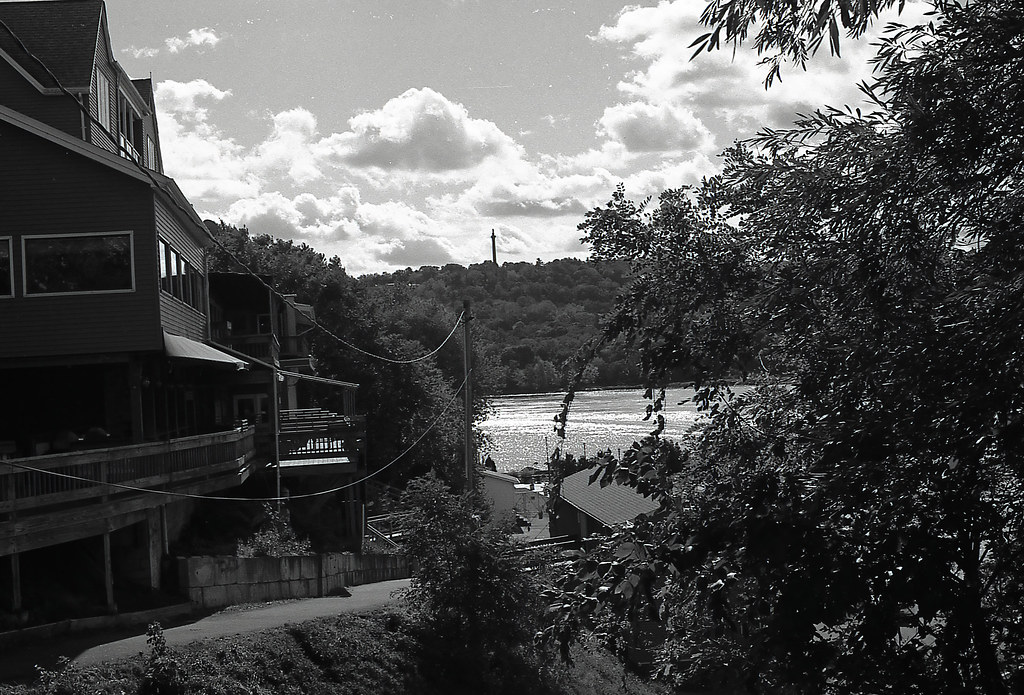
The view of Queenston Heights from Lewiston, New York where General Van Rensselaer launched his invasion of Upper Canada.
Contax G2 – Carl Zeiss Planar 2/45 T* – Efke KB50 – Blazinal 1+50 9:00 @ 20C
Brock had been right, at Lewiston, the American general in charge of the invasion of the center, Major-General Stephen Van Rensselaer, had problems of his own. Being a Militia General, he was looked down upon by the officers of the regular army. His small invasion force faced supply, pay, and morale issues as well. The well-timed ceasefire put little restrictions on the Americans, and by the time Brock arrived at Fort George there was no chance of being able to establish a British beachhead in New York, but only watch as Van Rensselaer’s army grew. Brock’s hands were tied. When the ceasefire expired on 8 September 1812, there was no sign of a permanent peace. Brock moved quickly, establishing new artillery batteries between Fort George and Fort Erie, fortified Chippawa and Queenston and deploying his troops as best he could. His garrison did receive a boost in the form of the arrival of the 49th Regiment of Foot from Quebec City. Despite his reinforcements, Van Rensselaer still faced problems with his command, and to make his headaches worse, General Dearborn wanted an invasion before Winter set in. And mother nature was about to makes matters worse.
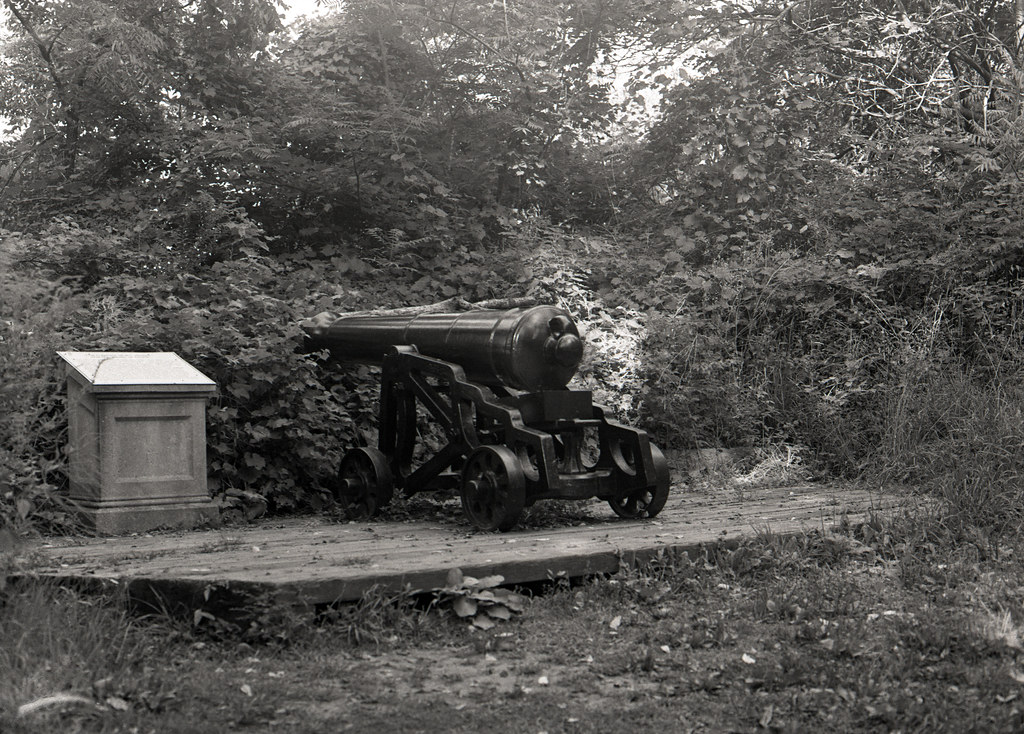
The Redan Battery up on Queenston Heights would cause the most damage against the American landings and see the first major skirmish of the battle.
Pentax 645 – SMC Pentax A 645 75mm 1:2.8 – Kodak Tri-X 400 – Kodak HC-110 Dil. B 6:00 @ 20C
As September turned to October, the Americans had made several attempts at a crossing only to be turned back by the weather; it did little to help the British in determining where the Americans would land but it did keep the garrison on their toes. The weather would slack, and under a cold drizzle on 13 October 1812 the conditions would be the best, and the invasion would begin. The first boats slipped out under cover of an early morning fog towards the small village of Queenston. Sharp-eyed sentries would quickly sound the alarm, and the whole riverbank erupted in fire as cannon and musket spat out in the early hours causing havoc on the American boats. Across the river, the American commander of Fort Gray at Lewiston could not even support the boats as the fog made it impossible to get a good line of fire on the British while avoiding his men. At Fort George, the nose of the artillery fire woke General Brock who called up the garrison and rode off towards Queenston.
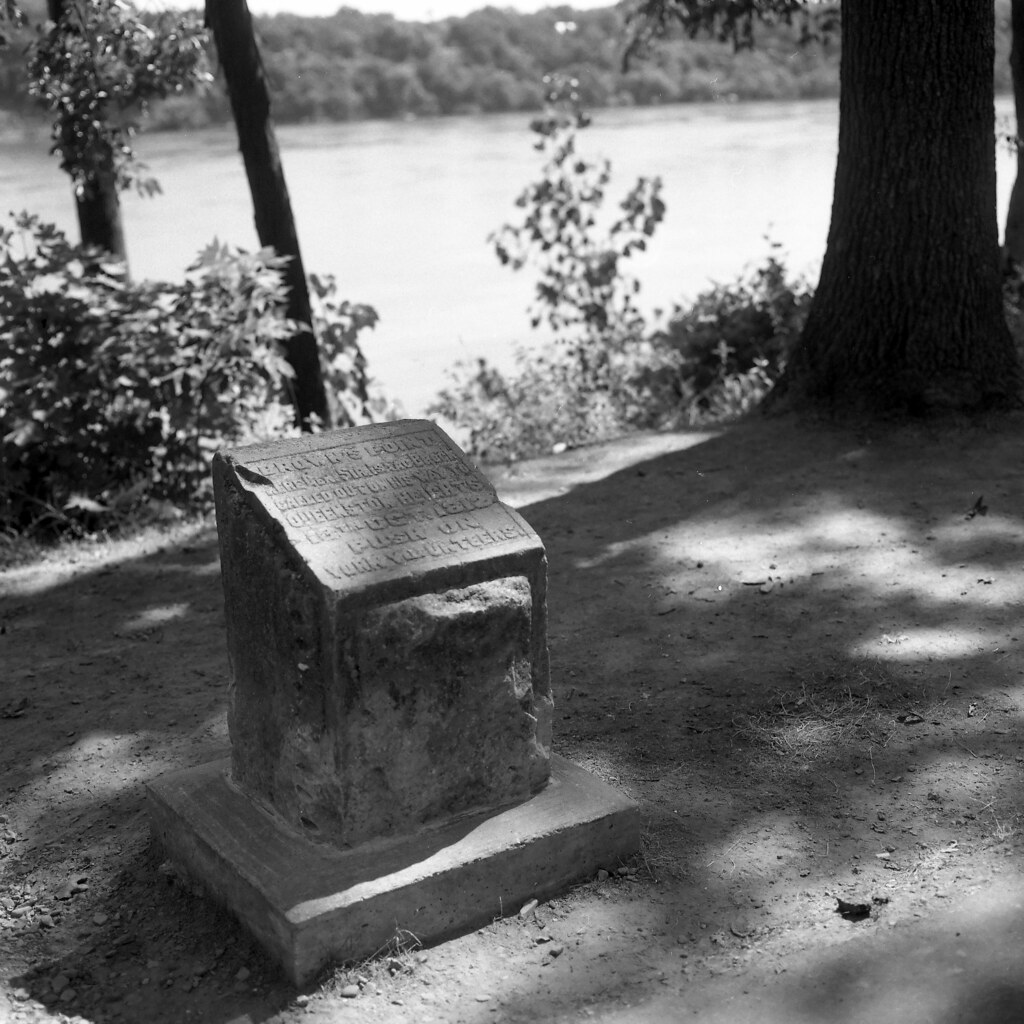
Local legend states that as Brock rode past Brown’s Point, he saw a group from the York Militia, he called out “Push on Brave York Volunteers” as his rode past. A monument now stands at the point.
Bronica SQ-Ai – Zenzanon-PS 65mm 1:4 – Ilford FP4+ – HC-110 Dil. B 7:00 @ 20C
While many boats sank under British artillery during the crossing, a few managed to land, their occupants now under heavy fire from the British garrison at Queenston. The first wave’s commander, Colonel Solomon Van Rensselaer, having been mortally wounded in the crossing had turned over command to Captain John Wool. Wool had no intention of letting his men die on the beach. His scouts, however, would present another option. A small fisherman’s path that ran up the Heights and out of view from the British gunners on the Redan Battery and the troops stationed in the village. Taking advantage, the surviving troops scaled the heights unseen, as they waited in the woods to attack from behind Wool witnessed a curious sight, the company of British regulars marched down the hill towards the village. The remaining militia troops put up little resistance. The Heights now belonged to the Americans. Fort Gray’s batteries had been freed up as well as the fog lifted and managed to put the battery of guns in the village out of commission as well giving the Americans leave to land more troops. In the chaos, the British forces in the village were starting to get pushed back, until the timely arrival of General Brock on horseback.
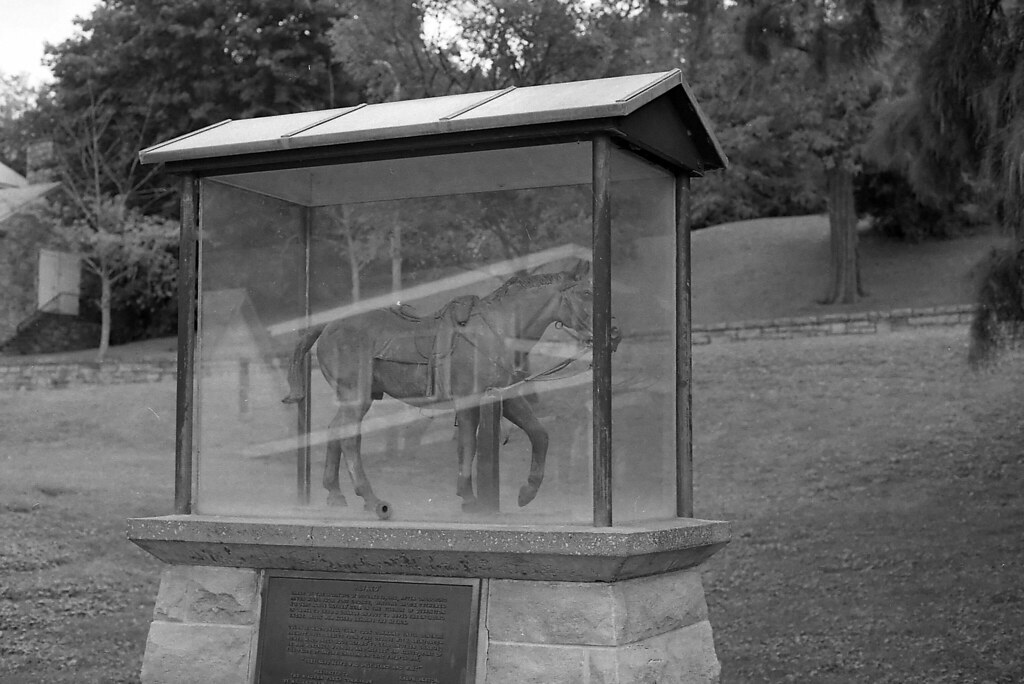
One of the stranger memorials to the battle, a memorial to General Brock’s Horse that would survive the engagment and was present at the General’s funeral.
Nikon FM2 – AI-S Nikkor 50mm 1:1.4 – Kodak Tri-X 400 – HC-110 Dil. B 4:30 @ 20C
Brock was a man of action, using the surviving troops from the 49th and militia stationed in the town, he got down from his horse and steadied the line. Resplendent in scarlet and gold he drew his sword and took the position at the front of the line. A man of action, Brock led from the front and knew that as long as the Americans held the heights, the battle would be lost. And only bold action could dislodge them. He ordered the advance; the line only faltered once. And a quick rebuke from the General stirred them into action. Up the hill, they charged, even though such a move was suicide. The tall general made for a tempting target to American snipers on the heights, and when a single bullet pierced his jacket, the beloved General went down. Seizing upon the General’s effort, his aide-du-camp Lieutenant-Colonel John MacDonnell took up the banner and tried for a second time to charge the hill, he to would be shot. With the two captains from the 49th also injured the British resolve crumbled and they began to fall back in disorder, holding at the Vrooman’s Point battery, the only battery that was still in action.

A small clearing, just down the hill from the Redan Battery is the spot where Brock would fall, a memorial erroniously marks a different spot at the edge of Queenston.
Pentax 645 – SMC Pentax A 645 75mm 1:2.8 – Kodak Tri-X 400 – Kodak HC-110 Dil. B 6:00 @ 20C
Things were far from lost, the line at Vrooman’s held and the American’s on the heights, despite receiving reinforcements lead by Major Winfield Scott were not going anywhere. Mohawk Warriors lead by Captain John Norton of the British Indian Department took to the woods, their war cries and musket fire held the Americans right where they were. Across the river, despite best efforts, the remaining troops refused to cross. Fearing both their lives and scalps, and the distraught Scott was promised only boats should he desire a retreat. The American invasion had faltered, and General Sheaffe was moving up the rest of the garrison. With the arrival of British reinforcements, the British quickly retook the village and began to pound the Americans up on the Heights. But Sheaffe was not about to make the same mistake that got Brock killed, opting instead to listen to the Mohawk Guides, who lead him around and up a second trail to flank the American positions.

A small weather worn marker just north of Queenston marks the spot that Sheaffe would lead the British to victory.
Pentax 645 – SMC Pentax A 645 75mm 1:2.8 – Kodak Tri-X 400 – Kodak HC-110 Dil. B 6:00 @ 20C
It had been almost twelve hours since the invasion began when Sheaffe began the final maneuvers that would end it. The surprised Americans took to their field defenses as the combined force of British Regulars, Mohawk, and Militia lined up for battle. Scott ordered what few men he had to fight. A single British volley had crashed through the American lines before they charged in with bayonets fixed. Scott’s army retreated in disorder, charging headlong down the heights to the riverbank and the waiting boats. No boats had arrived. Scott was left with little choice to surrender. When his first officer was shot trying, he stood up and waved a white flag only the arrival of a British officer saved from more death. And much to the American commander’s dismay, many American troops appeared from their hiding place, signaling their surrender.

A memorial to all the native troops that served during the Anglo-American War of 1812 was errected on Queenston Heights in 2017.
Kodak Pony 135 Model C – Kodak Anaston Lens 44mm ƒ/3.5 – Efke KB 100 @ ASA-100 – Kodak HC-110 Dil. B 5:30 @ 20C
For the British, the loss of General Brock was a huge blow, the general was much loved by the troops, and his leadership would cause a series of mishaps in British Command until the arrival of General Gordon Drummond in 1814. For the Americans, the loss at Queenston Heights would signal the end of their attempt to force the end of the war quickly. Van Rensselaer would give up his command and retire in disgrace. Winfield Scott would eventually be returned in a prisoner exchange, but his experiences as a British Prisoner of War would see him become one of the best commanders in the American army and he would carry a grudge against the British for the rest of the war. Brock would receive a hero’s funeral, attended by hundreds when he was interred at Fort George, a marker in Brock’s Baston remains to this day. He and MacDonnell would eventually be buried on Queenston Heights beneath a massive monument that still stands on the heights to this day.
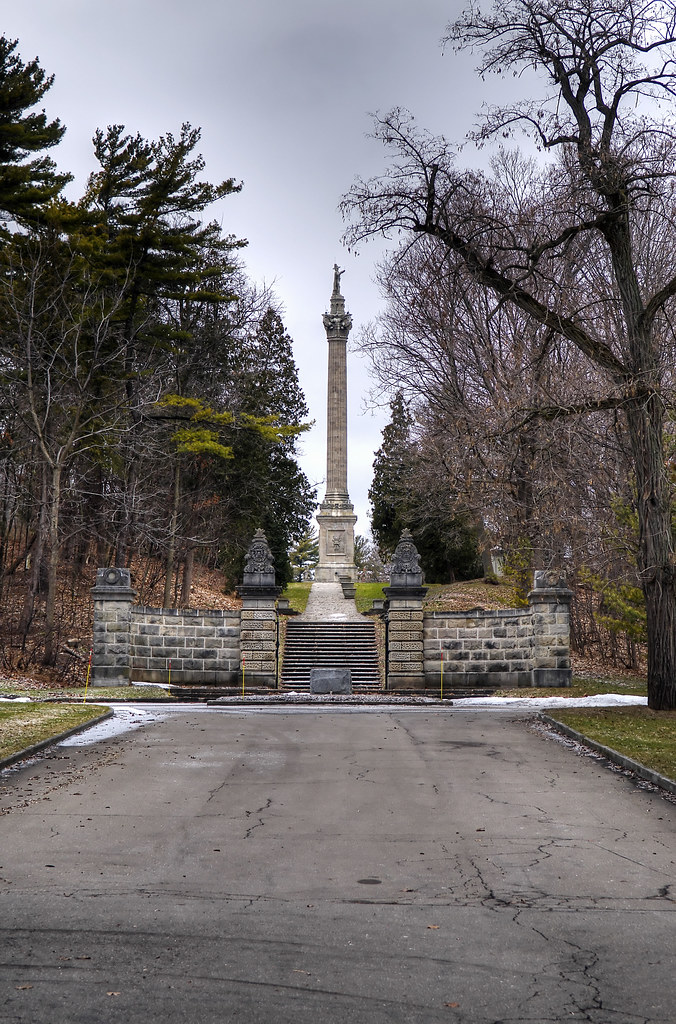
Brock’s Monument as it stands today is the second moment, the first being destroyed in an act of domestic terror shortly after it was opened.
Nikon D300 – AF-S Nikkor 17-55mm 1:2.8G DX
Today the Battle of Queenston Heights stands in legend as one of the first major battles of the Anglo-American War of 1812 and as entered into the realms of Canadian mythos that surrounds the war. Today the Heights is a popular picnic destination, and Brock’s Monument stands still today. During the spring and summer visitors are welcome to climb to the top. On 13 October 2012, a reenactment of the battle featured 500 British and 300 American reenactors put on a demonstration including a march from Fort George to the Heights which I was honoured to participate in both. If you desire, you can watch a video of the action below.
Written with files from:
Guidebook to the Historic Sites of the War of 1812 Second Edition by Gilbert Collins – 2006 The Dundurn Group Publishers
Malcomson, Robert. A Very Brilliant Affair: The Battle of Queenston Heights, 1812. Robin Brass Studio, 2014. Print
Hickey, Donald R. Don’t Give Up the Ship: Myths of the War of 1812. Urbana: U of Illinois, 2006. Print.
Berton, Pierre. The Invasion of Canada: 1812-1813. Toronto: McClelland and Stewart, 1980. Print
Lossing, Benson John. The Pictorial Fieldbook of the War of 1812. Gretna, LA: Pelican Pub. 2003. Print.
Web: www.eighteentwelve.ca/?q=eng/Topic/15
2 Comments